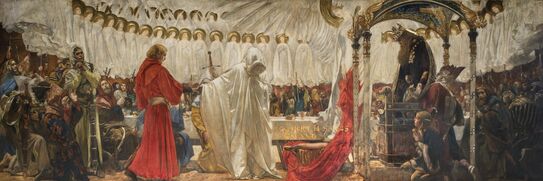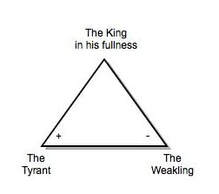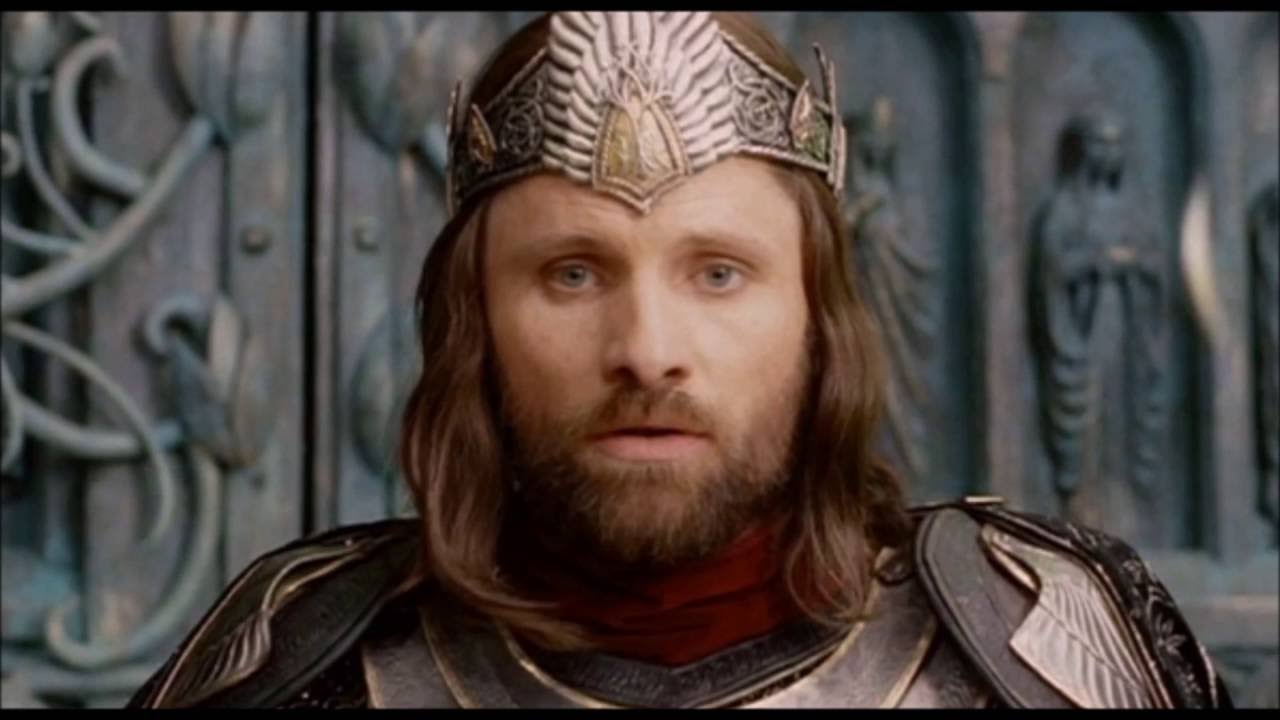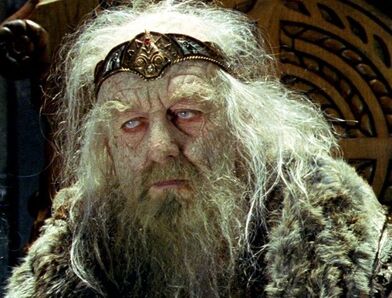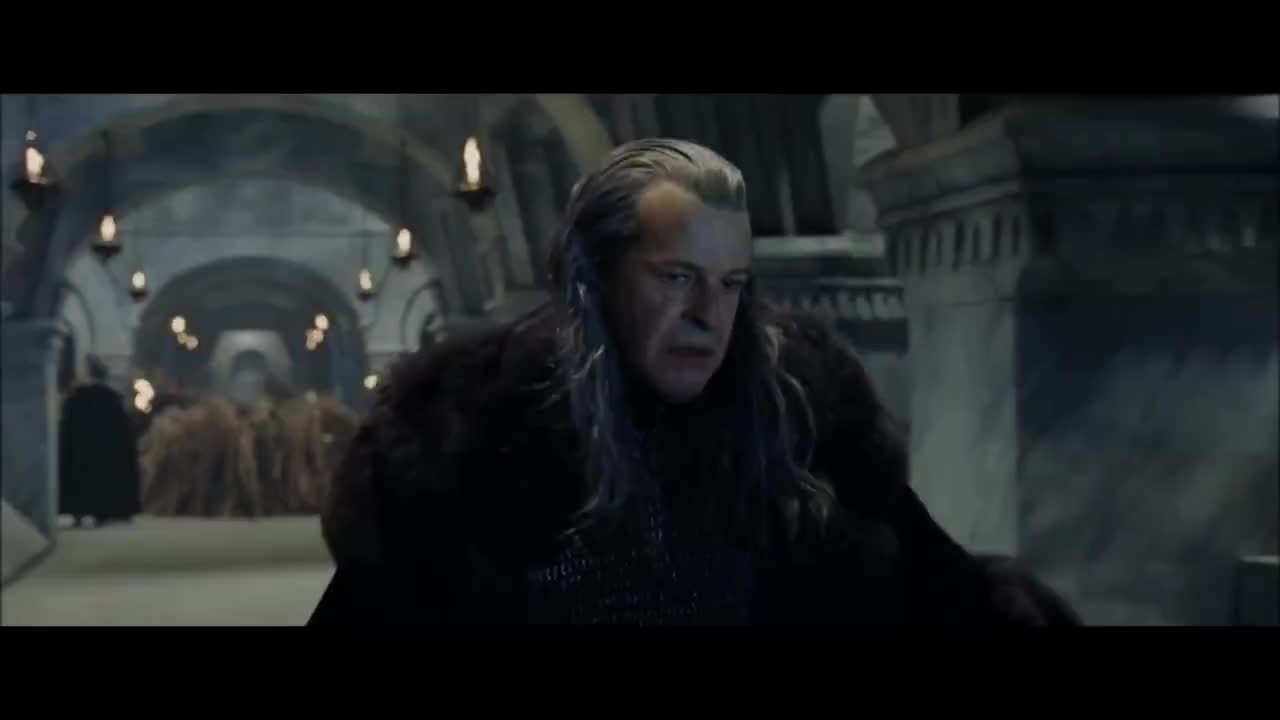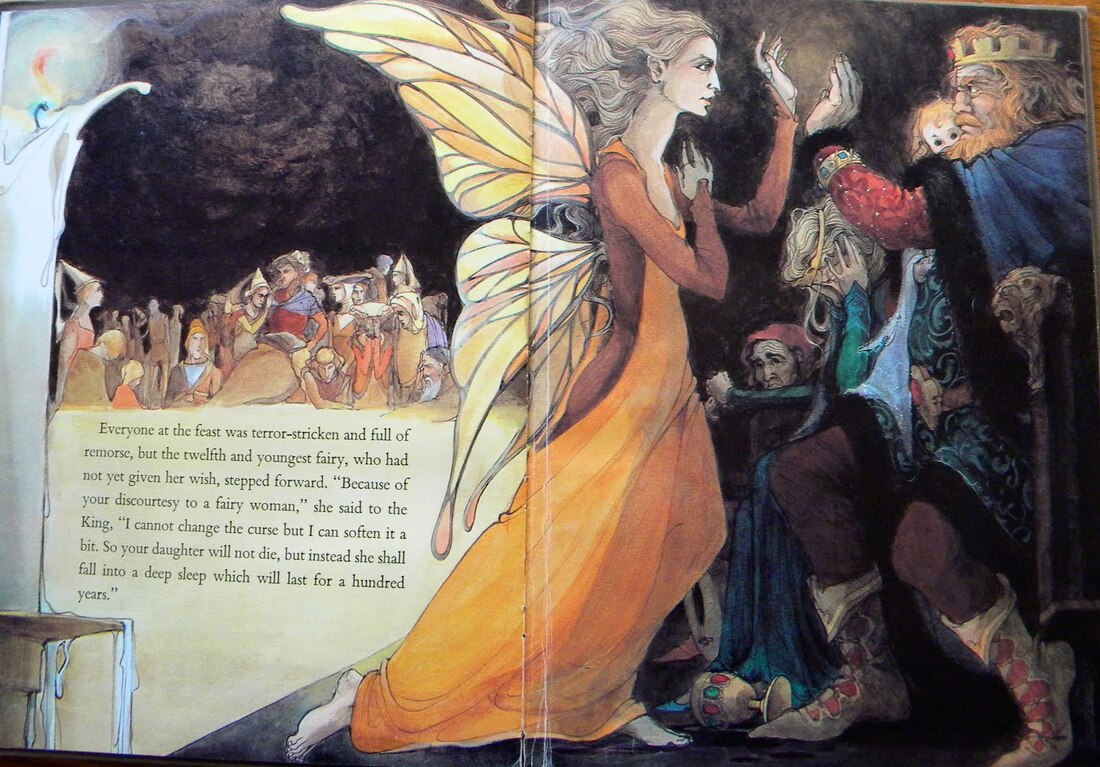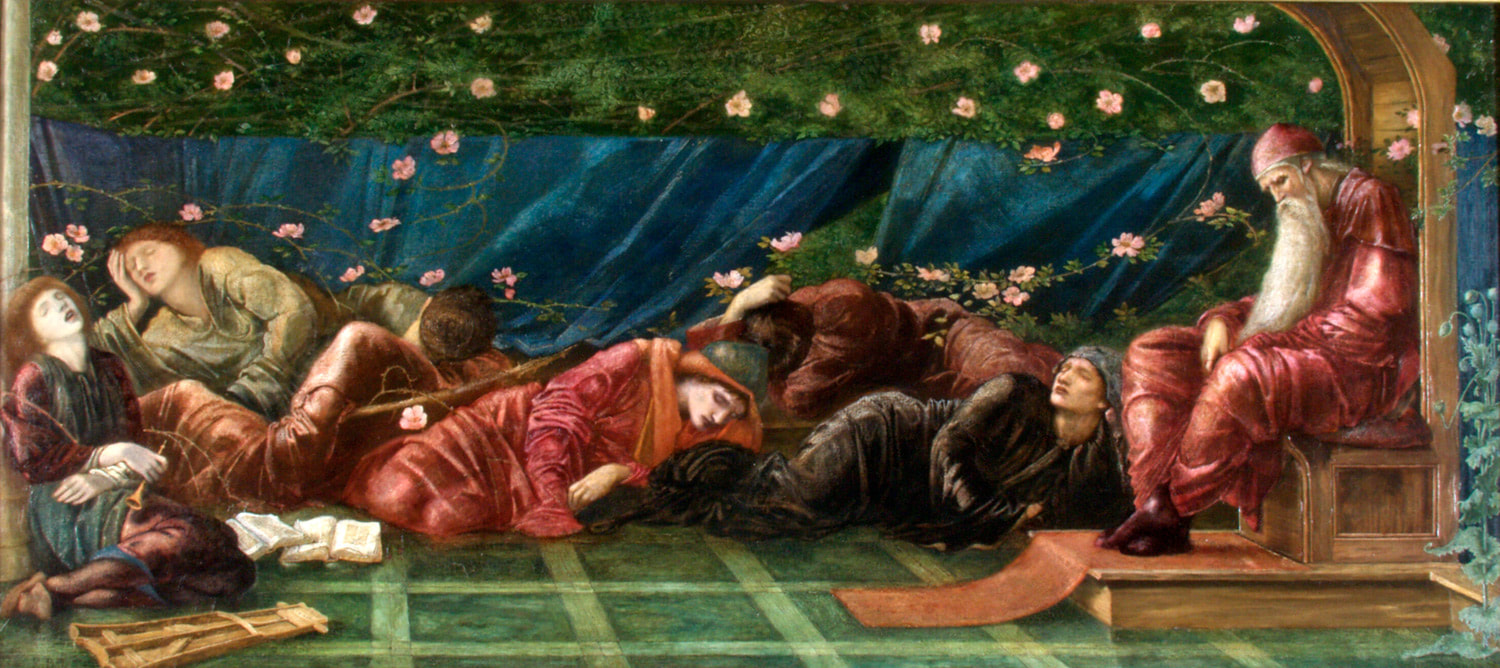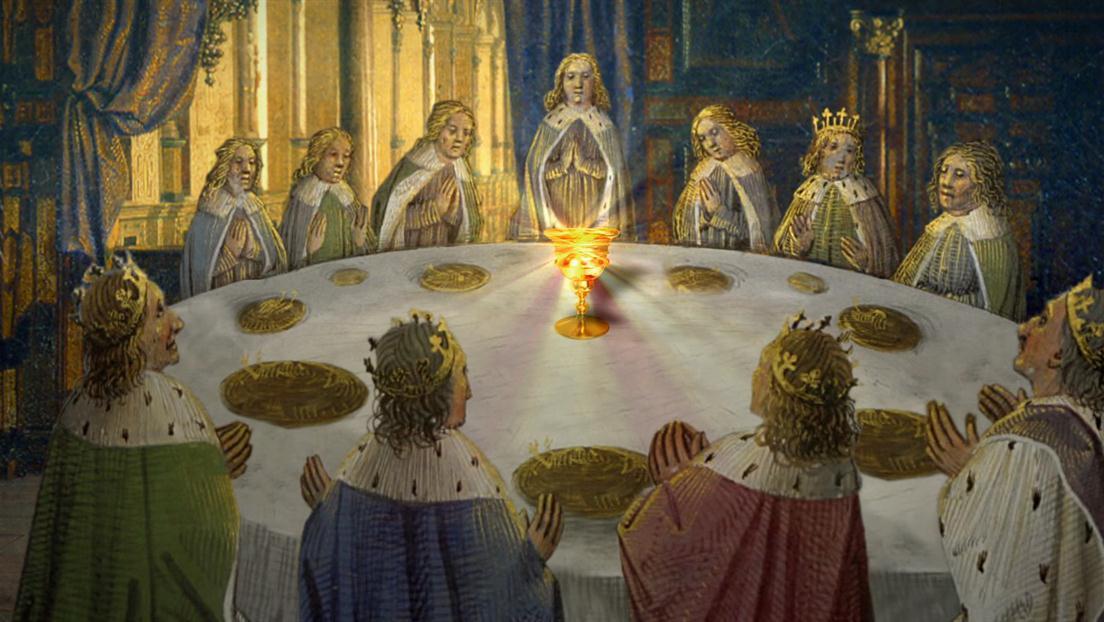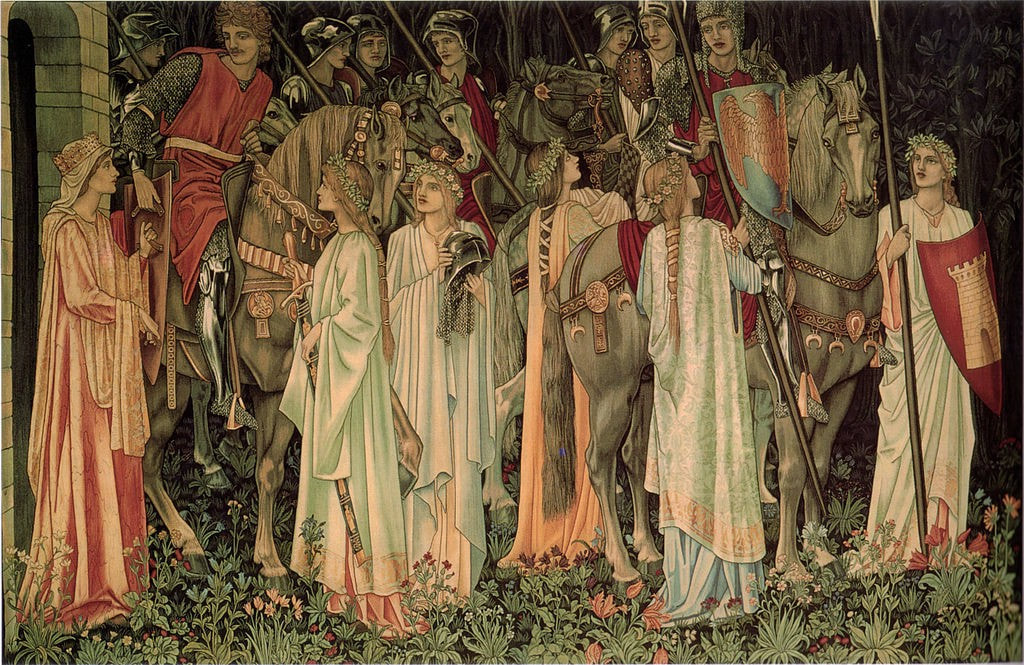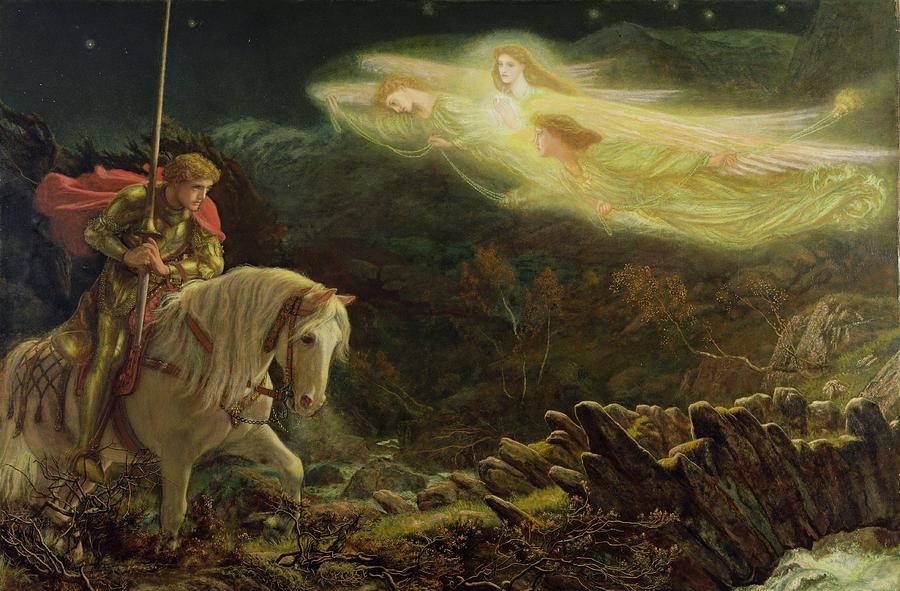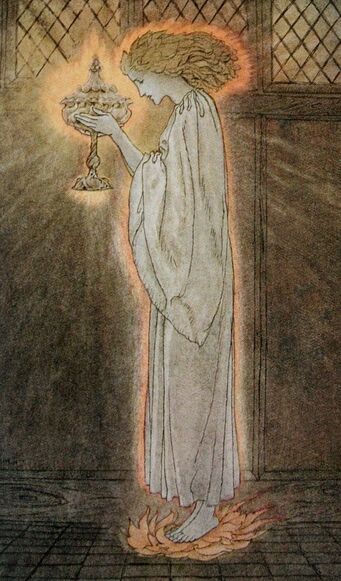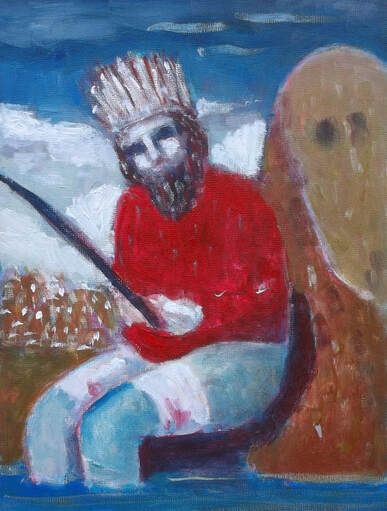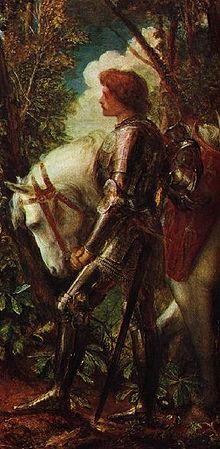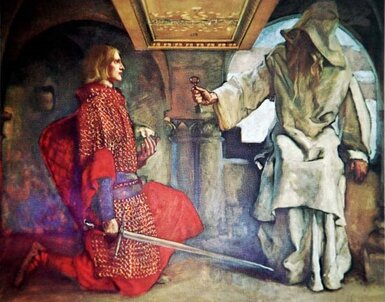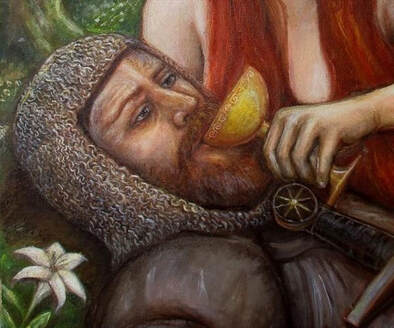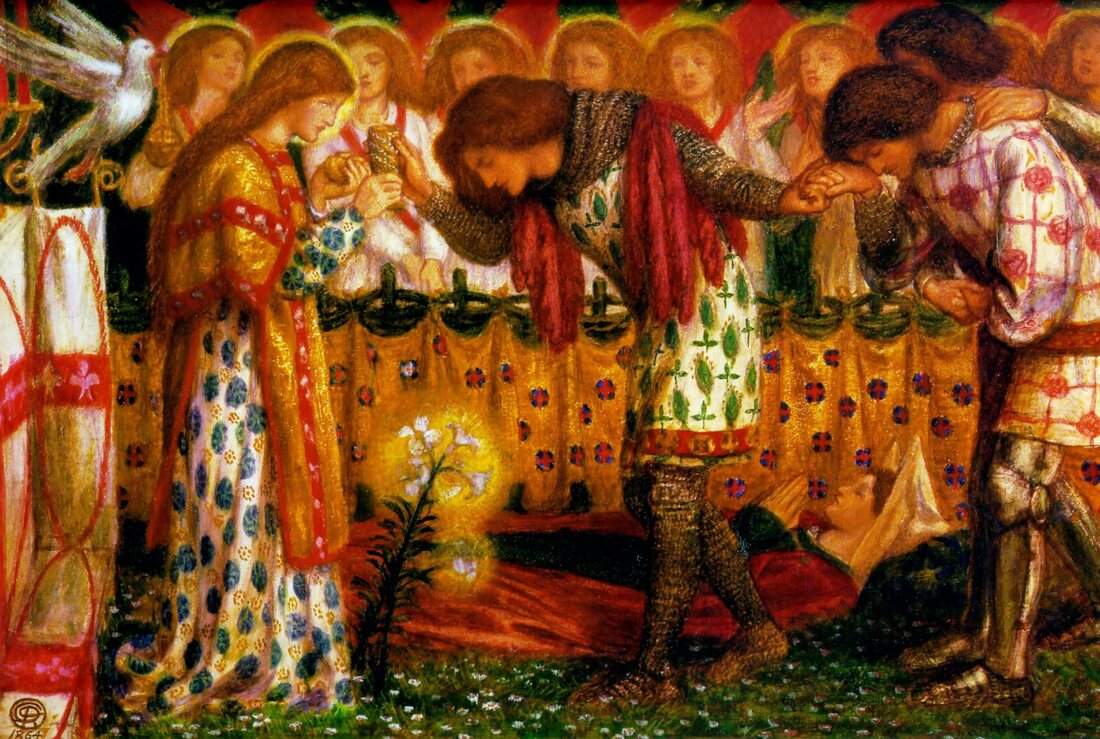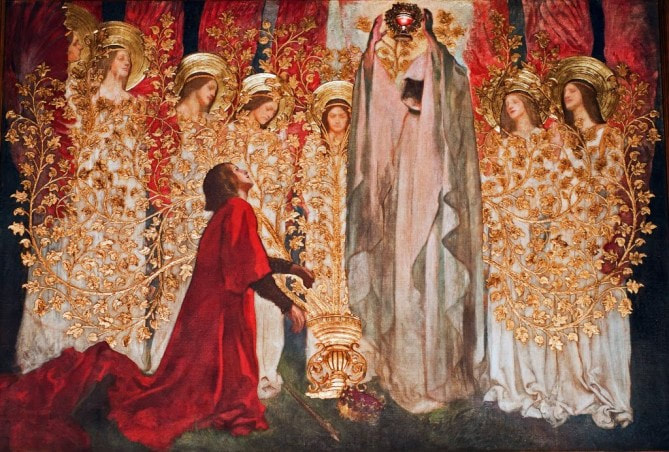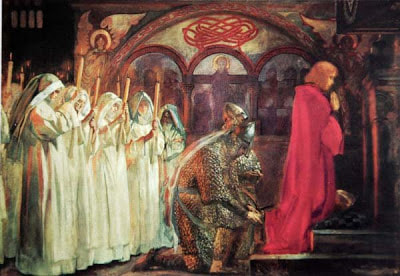For all four archetypes in their study, Moore & Gillette have created a pyramid shaped diagram showing the mature expression at the peak and two dysfunctional - bi-polar like expressions at the base.
That being said, there is no such thing as a wholly sorted King; for even the best are always only human and subject to human frailty.
Myth, Legend and fairy tale show us all these aspects writ large.
Health of the King
Order & Blessing
He holds audience, primarily, not to be seen, but to see, admire, and delight in his subjects, to reward them and to bestow honours upon them.”
Moore & Gillette -
Mufasa: A king's time as ruler rises and falls like the sun. One day, Simba, the sun will set on my time here, and will rise with you as the new king.
The Wounded King / The Shadow King
In the end both Kings die. But unlike the King of Rohan, who is spectacularly released from his enchantment by Gandalf and given the opportunity to redeem himself in one final battle - Denethor the steward is driven by his madness to take his own life. These two Kings - one fallen, one corrupted, are worthy of a study in their own right and perfectly exemplify Moore & Gillette's bi-polar end of the King archetype pyramid.
The King in Sleeping Beauty
When the tale begins the king and queen are longing for a child but after seven years of marriage there is no sign. This reflects a generalised lack of fertility within the kingdom – a state of stuckness. The old values are maintained, clung to even and renewal prevented.
It takes a slimy green frog to emerge from the depths – to nudge things in the right direction – he is clearly a messenger from the unconscious - from the soul if you like - a voice that only the Queen can hear - and sufficiently potent for her to take matters into her own hands. It seems superficially in many renderings of the tale that the lack is with this Queen - yet the picture as a whole suggests otherwise.
Yet even after the birth of the Princess, the King continues as before - recklessly ignoring the words of the thirteenth fairy who has arrived unbidden and placed a curse on his beloved child. She will prick her finger on a spindle on her 15th birthday - as well we all know. But the king is all done with fairies and wishes and curses and not believing in this superstitious nonsense has all the spindles destroyed. Job done as they say – or so he naïvely believes. But fate will have its way, as we know, resulting in the entire palace, with his beautiful daughter at its heart being plunged into darkness, into sleep and deep unconsciousness - for One Hundred Years.
The Wounded King at the heart of the Grail Quest
In Camelot the wizard Merlin cries out that a king lays terribly wounded at the heart of that place - and will never be cured until a knight - foremost amongst those seated at the round table has done mighty deeds of alms, of bounty and of nobility - and only when he has asked, what one does and whom one serves with the Grail, will the King be cured and the enchantments fall which are at present in the land of Britain.
Burne-Jones & William Morris
But of the many brave knights who took up willingly this most high and holy challenge, three alone were destined to succeed and these were Sir Galahad, Sir Bors & Sir Percival, the perfect fool, whose story we shall take up briefly here.
The story tells that it was to him that a pathway to the lost castle was first revealed and that soon after he arrived at a small chapel within where the wounded king cried out in his torment. And there he witnessed a mysterious procession during which a bleeding spear and carved stone dish were carried through the interior of that place, led by a damsel of pure and matchless beauty who bore the Holy Grail itself, veiled beneath a cloth of silk. And the light that shone forth from that vessel was so bright that even the stars in the night sky were put out by it.
But Sir Percival remained silent and straightaway the castle and all its inhabitants vanished and the young knight found himself all alone once more in the desolate wastes of forest where very soon after, the beautiful damsel who had borne the Holy Grail appeared to him. Though her countenance and her form were much changed and it seemed to our hero that all the weight of time had come suddenly upon her and she rebuked him saying that his failure to ask the essential question has much prolonged the agony of the Wounded King who can now neither die nor find relief from his torment. Nor can the wasteland or her own lost beauty ever be restored until that question is finally asked.
His health is paramount as we have seen, reflecting the vitality of the entire kingdom. In several versions of the legend we are introduced to him as the - rich fisherman. A sad, wounded figure hunched over his rod in the vain hope of catching a fish from the stagnant waters that surround him.
The consequence for the Grail King is the chronic genital wound he suffers and the infertility that has followed. He has stagnated, like the pools in which he fishes in vain, doomed in his agony to repeat the same old ritual every night of being carried to the hall where the Grail is present, but never ever being able to partake of its mystery of its healing.
As individuals too we can all from time to time become like the Fisher-King - when our zest for life is lost, when we lose connection with our own internal Sacred Space & its regenerative force. Then we no longer care for our own internal kingdom, for our own bodies even. Our worlds become flat and colourless. We have lost the paths to own Courts of Joy, our own soul's replenishment.
Until of course - in fairy-tale speak - a young knight of great destiny - that part of ourselves - arrives to ask the pivotal question - the question that will turn it all around.
But he is young, he is naive - overawed by the moment, inexperienced when he first arrives as we have seen. He has not long left home we are told, and the domain of his mother. He still wears her home spun vest. It is she who has told him always to be polite and not ask too many questions. He has great aspirations to be a worthy knight but has still to prove himself. His failure at the Grail Castle reflects all these things. He was simply not ready, not mature enough.
Well for seven years thereafter Sir Percival wandered the forest, seeking endlessly to retrace his steps. And trial and tribulation met him at every turn and all his good intentions were tested to the hilt in otherworldly adventures too numerous to mention here – but let it be understood that often times he was brought to the brink - and that which was light appeared darkly to him and that which was dark shed out abundant light and in this way he was put severely to the test and helped and hindered according to his need, until finally, when the seven years were passed and gone there dawned a wisdom in his heart and he was enabled to arrive at the dwelling of a hermit who presented him with a golden key, a silken cloak embroidered with the image of a golden dove….and directed him to the mysterious castle, which surprisingly was very close by.
Now no one knows exactly how he proceeded from that place - some say it was by way of a perilously narrow bridge that appeared then before him - yet others proclaim that magically, the great golden wings upon his cloak quickened and stirred to life and he at once borne upward and onward to the castle of the grail ahead.
And there a place is already prepared for him at a great round table, where sit the seekers and the keepers of the Grail, from all the centuries of the quest including Sir Galahad and Sir Bors from Camelot and elves and fairy folk too and men and women strangely clad, from times still yet to come.
And all there feasted together as one company and each had a tale of wonder to impart - then the young Sir Percival, with the knights of his own time was led to the small chapel within, where still the wounded king cried out in his torment and he witnessed again the magnificent procession of the Holy Grail, the mysterious bleeding spear and carved stone dish - and when at last he asked
What one does and whom one serves with the Grail, it was immediately given into his hands and he understood that he must offer it to the wounded and long suffering king. And as he placed the holy vessel to the parched lips of that man, he was at once completely healed, and wasteland burst forth into a glorious flowering of spring.
Now the legend tells that afterwards, the three knights of the Grail were spirited away on the Ship of Solomon, to the High City of Sarras where a final mass of the quest was celebrated midst a great company of angels. And at that time it was given unto Sir Galahad to bear the hallow of the sword to the high alter of that place followed by Sir Bors with that of the Spear.
But she who proceeded them all and who bore the Holy Grail itself, unveiled at last to the heavens, was the once dis-honoured maiden, whose beauty was now so restored that all who looked upon her imagined a glorious rising of the sun.... and unto her it was given to offer up the Holy Vessel - whereupon a wonderous being of light appeared from within saying.
"My Knights & my servants & my true children,
Who are come out of mortal life into spiritual life.
I will no longer hide from you.
But you shall see a part of my secrets & my hidden things,
Now hold: and receive the high meat you have so long desired."
Then he took he himself the Holy Vessel & came to Galahad, who kneeled down & there received his Saviour. And after him, so received all his fellows. Then He took He Himself the Holy Vessel & vanished.
Now it is said that then Sir Galahad expired 'in an odour of sanctity' whilst Sir Bors returned to Camelot with stories of the great quest - but Sir Percival - the perfect fool - remained at the Castle of the Grail - until the next hero of the quest, arrives to take his place.
Quest for the Grail - adapted: Anne Maria Clarke 1994
Renewal of the King
Burne-Jones & William Morris
Several authors over the centuries have added their - Continuations - and brought the tale to a dramatic & powerful climax. And yet there is something so powerful about leaving it undone. The hope created by the missing ending of course is that we might take it on for ourselves - that we too will go forth whenever the need arises - and one day arrive at this point - and take the road ahead that leads to our transformation - ask the pivotal question - and in so doing - lift the enchantments that are at present in ourselves & in our lands.
It is one of the prime mistakes of many interpreters of mythological symbols to read them as references - not to the mysteries of the human spirit - but to actual or imagined historical events....such as a newspaper reporter might have witnessed. Whereas it is one of the glories of the Grail Tradition, that in the handling of religious themes, it retranslates them from the language of imagined facts into a mythological idiom; so that they may be experienced, not as time-conditioned, but as timeless; telling not of miracles long past, but of miracles potential within ourselves, here, now, and forever.
Joseph Campbell: Hero with a Thousand Faces
x x x
Chrétien de Troyes's Old French verse romance,
the Conte del Graal ('Story of the Grail'), or Perceval, of c.1180
Wolfram von Eschenbach's Parzifal (early 13th century)
Sir Thomas Malory's Morte Darthur (late 15th century)
Healing the Wounded King: Soul Work and the Quest for the Grail: 1997
John Matthews
King, Warrior, Magician, Lover: Rediscovering the Archetypes of the Mature Masculine 1992
Robert L. Moore, Douglas Gillette
He: Understanding Masculine Psychology
Robert A. Johnson
The Hero with A Thousand Faces (The Collected Works of Joseph Campbell)
Joseph Campbell
https://twitter.com/MariaClarke
